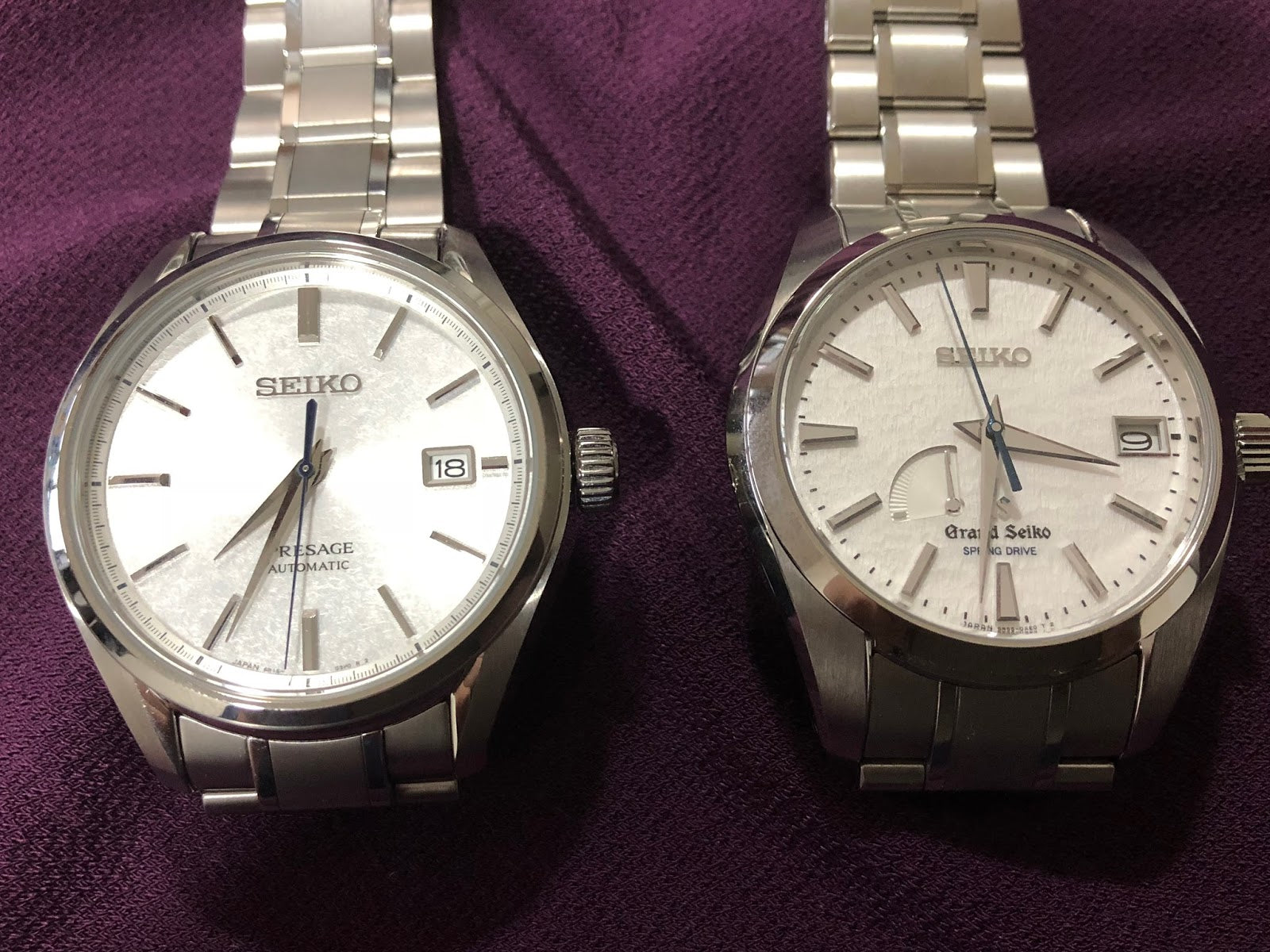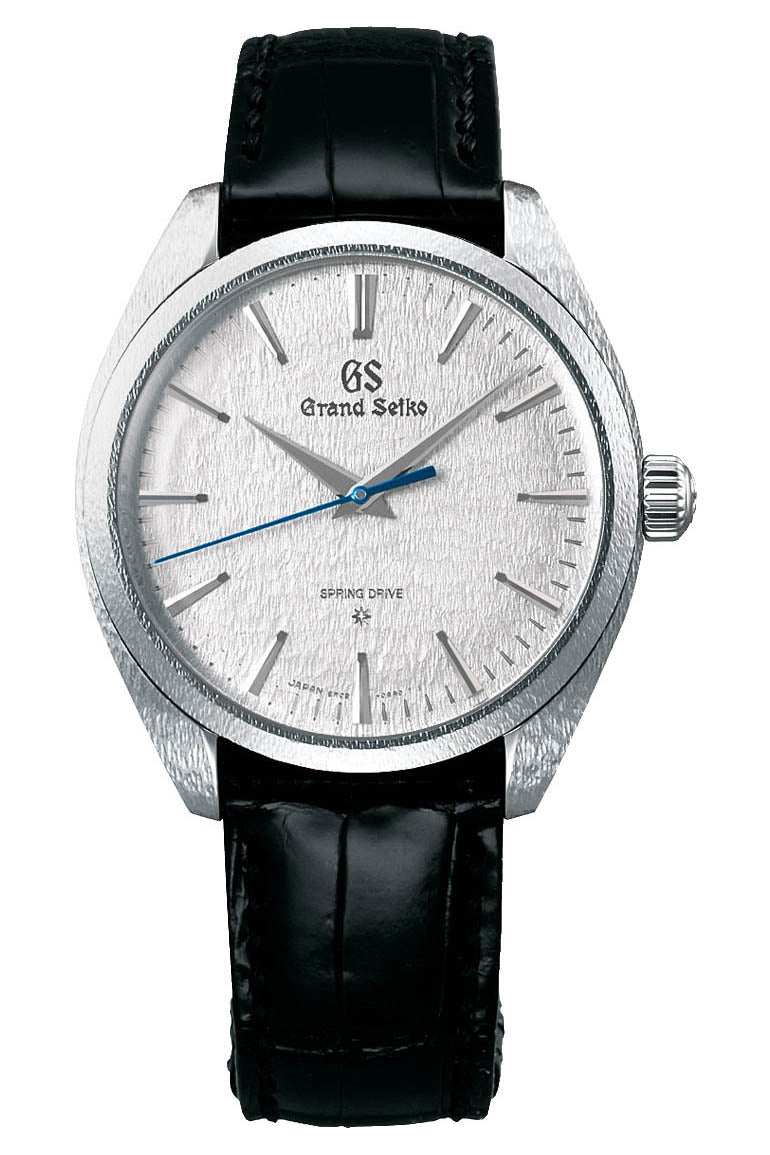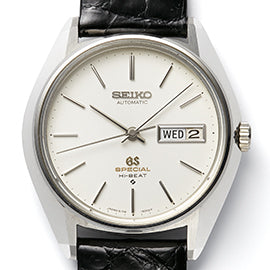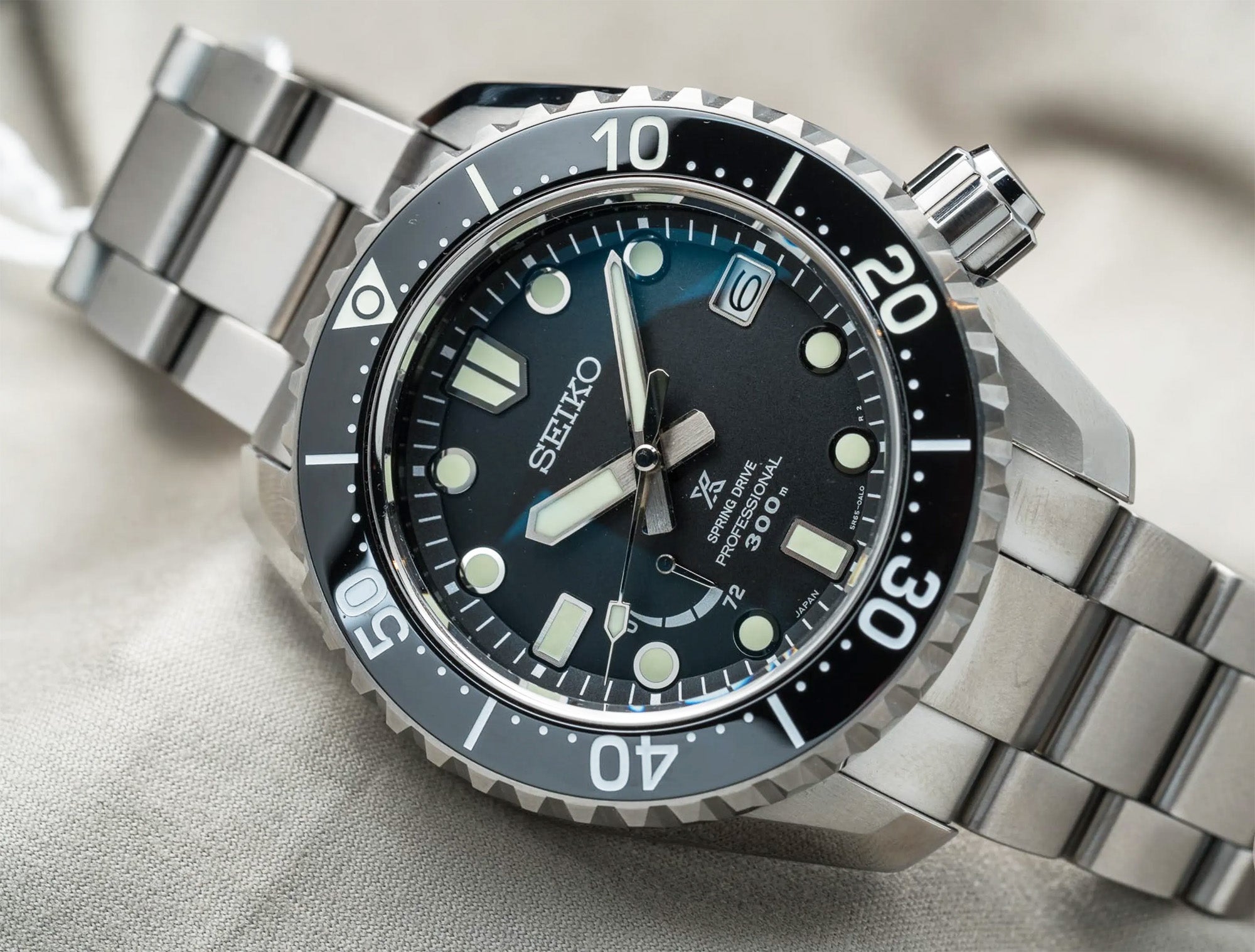Grand Seiko vs Seiko - Grand Seiko Timeline (Part 2)

Left :Seiko Presage “Cocktail” Sakura Hubuki ref. SSA361 / SRPC01, Right : Grand Seiko Hi-Beat GMT Grand Seiko SBGJ235
Seiko is, for decades, one of the most famous brands of watches, but many people out there wonder what is the difference between the brand itself and the term “Grand Seiko”. As Google’s search engine suggests, besides wondering what is the difference between Seiko and Grand Seiko and ‘is Grand Seiko owned by Seiko’ at all, people often assume that Grand Seiko is Seiko’s sub brand. That would, at least, be an understatement, as well as thinking that the two have a lot in common, except the brand name.

Seiko Presage vs Grand Seiko, Image source: watchtime.me
Charles Miller explained it nicely on its watch buying guide for Watch Shopping by comparing Seiko and Grand Seiko to Toyota and Lexus. And it’s true, even if the parent company is the same for both brands; one of them is way more exceptional, luxury version. Yet, what also keeps them tied together are subtle touches from the outside and the fact engraved in everything made under Seiko roof – exquisite watchmaking on the inside. Watches from both Seiko and Grand Seiko series are often told to be superior over far more expensive timepieces from other brands. But Seiko’s craftsmanship is also a dividing point between the two. Simply said, Grand Seiko is a high-end Seiko watch, meaning everything about the Grand Seiko watches is more carefully made, in terms that each watch is still assembled by hand. To paraphrase the words of some of the owners of Grand Seiko timepieces – ‘everything is more precise’ (compared to other Seiko watch lines). While parts for other Seiko watches are usually made by machines, Grand Seiko invests more into handwork. Other than that, Grand Seiko uses different materials (from higher grade stainless steel to platinum) and has distinctively polished cases. To sum it up, if Seiko stands for excellent watchmaking, Grand Seiko means superb devotion to each timepiece.

The most expensive Grand Seiko watch - SBGZ001 Spring Drive Platinum case, 8 million yen / $76,000

The most expensive Seiko watch - Seiko Prospex LX Spring Drive SNR029J, $6,000
Naturally, Grand Seiko watches are usually sensibly more expensive than watches from other Seiko lines. While prices of other Seiko brands rarely go over $1000-$2000, Grand Seiko pieces usually start from $2,000 and go up to several tens of thousands of US dollars. Therefore, Grand Seiko targets more serious watch collectors.
Grand Seiko history in short
To answer the questions from the beginning, we’ll have to go back to the very roots of Grand Seiko line. The idea of Grand Seiko started around the middle of the past century in the minds of Seiko craftsmen who wanted to build an ideal watch that will challenge the standards of watchmaking. The first Grand Seiko was released in 1960 and was the exact fulfillment of the idea. It had a new, 3180 caliber with accuracy of +12/-3 seconds a day, with astonishing power reserves for that time. It was also the first Japanese watch that was compliant with the COSC standard of excellence (The Contrôle Officiel Suisse des Chronomètres), the Official Swiss Chronometer Testing Institute, responsible for certifying the accuracy and precision of Swiss watches. So yes, the first Grand Seiko made history, but that was just a start.

The first Grand Seiko in 1960 with 3180 caliber, Image source: grand-seiko.com
Four years later, in 1964, the Grand Seiko Self-dater with calendar function and upgraded water resistance bought even more watch-loving hearts, but just three years after, 44GS set a new bar and had the greatest influence on all following watches under the brand. With new watches, new calibers were introduced and it was all happening quickly. The year 1967 also brought the first automatic Grand Seiko – 62GS.
Launch of the specially adjusted watch, V.F.A. (Very Fine Adjusted)
Among events worth mentioning, Grand Seiko was awarded in Geneva observatory competition in 1968, for the best mechanical watches. The world then learned that only the best movements make it into the belly of Grand Seiko pieces. Naturally, all the accomplishments were no accidents, but rather results of continuous effort, helped by inventions and fueled by true passion. One such invention changed the course of Grand Seiko, when Spron alloys were used to enhance the mainsprings, which drastically improved the accuracy (±2 seconds per day), which was, at the time, wicked. Hence, ‘ultra-high precision’ models followed under common name “Grand Seiko Very Fine Adjusted” (marked as GS V.F.A.). The two of them became legends: 61GS V.F.A. and 45GS V.F.A.

1969 Grand Seiko - 61GS V.F.A.

1970 Grand Seiko - 61GS Special, Caliber 6156

1972 Grand Seiko - 61GS V.F.A.
The first Quartz Grand Seiko
After pioneering quartz watches, pursuing the idea of the ideal watch with time led Seiko onto quest to make the ultimate quartz watch. Five years after the initial release, in 1993, Grand Seiko introduced a new quartz watch along with caliber 9F83, that united all of the essential qualities its makers wanted in a wristwatch: accuracy, beauty, legibility, durability and ease of use.
With the birth of 9F quartz movement, the watchmaking of quartz timepieces was redefined. But that was still far of what Grand Seiko designers and engineers dreamed. For example, in 2003, another new quartz watch was released that had astonishing resistance to magnetism, which protected its precision from being influenced by electronic devices and, again, left a mark on history of watchmaking.

Grand Seiko Caliber 9S 20th Anniversary Limited Edition, Image source: grand-seiko.com
The Grand Seiko mechanical watch
When it comes to mechanical calibers, Grand Seiko didn’t spare its efforts, too. The new generation of mechanical watches with 9S movement were introduced in the 90s. Along with it, the new standards were set, today simply called GS standards, which every Grand Seiko nowadays must come by. Aside from precision, longer power reserves and innovations in material, design and techniques were redefined, with no expense spared. For example, one of its evolutions was setting the power reserves of such watch to the goal of 72 hours, which was eventually achieved with caliber 9S67, introduced in 2006. Since 9S caliber series is, from its start, on the trace of becoming legendary, the exploration didn’t stop and neither did new horizons. Evolution of 9S came in shapes of Grand Seiko calibers: 9S85 (55 hours of power reserve), 9S86 (Hi-beat with GMT function), 9S67 (72 hours of power reserve), all of which are well-respected among collectors nowadays. That left 9S caliber to be one of the finest mechanical calibers on the planet in the years to come.
The birth of Spring Drive
Among the minds that dreamed big at Seiko, there was one who dreamed about the ‘everlasting watch’ and had the courage to challenge mechanical watches engineering to race with the accuracy of electronic watches. His name was Yoshikazu Akahane and the idea boggled his mind for more than twenty years. But finally, in 1999 aka 600 prototypes later, this persistent man finally succeeded in making what was called the Spring Drive. The Spring drive embodied the principle of reflecting the nature’s relationship with the passing of time.

Grand Seiko Spring Drive SBGA405 Godzilla 65th Anniversary, Image source: monochrome-watches.com
We’ll discuss the Spring drive in details some other time, but let us mention its main characteristics here. Simply said, it’s an upgraded mechanical Grand Seiko movement, made of a mainspring and a barrel, with the regulator instead of a balance wheel and an escapement. The regulator is actually Seiko’s Tri-synchro regulating system, which is a story for itself and includes quartz, so not even nearly as simple as it may sound, but you get the picture about differences between the Spring Drive and conventional mechanical movements. Basically, what Spring Drive does is combines the powers of mechanical and quartz watches. Therefore, it is no wonder Spring Drive’s accuracy can be specified to ±15 seconds per month. A revolution, for sure.
We will also take time to elaborate Spring Drive calibers in some other post, but let us now at least do an overview of some of them worth mentioning. The first Grand Seiko Spring Drive caliber was 9R65 and it combined a traditional mainspring with an electronic regulator, which was a revolution at its best. The watch was still powered by the motions of its wearer, but a level of accuracy was mind blowing for the era. What comes together wonderfully in Spring Drive movements are both electronic and mechanical mastering when it comes to watchmaking.
Spring Drive watches
Spring Drive easily found its way into Grand Seiko pieces but it was way too good to be kept other Seiko brands, with Prospex benefiting the most. As you may notice, even as Seiko has some truly awesome calibers out there, watches with Spring Drive may be somewhat more expensive. It isn’t exactly a rule, but it’s often the case. But when you take into account that Spring Drive uses Spron alloy (copper-nickel alloy to be exact), which has a high elasticity and durability, and great resistances to heat and corrosion, plus add the accuracy, that justifies their price quite nicely.

Seiko Prospex LX Collection With Spring Drive Movements, Image source: fratellowatches.com
The Seiko Prospex LX line envisions the “True Spirit of Seiko”, but also a soul of Grand Seiko, with a Spring Drive inside (Spring Drive GMT 5R66 or Spring Drive 5R65) and Zaratsu steel finishing. The name LX represents the Latin word for light and the way the light is reflected on its smooth cases. The prices of these watches pursue the higher end when it comes to Seiko (but not as high as some Grand Seiko pieces) by ranging between $5,000-7,000. But the mingle of Spring Drive with Prospex series doesn’t stop there. More than a couple of Seiko Spring Drive divers also hit a higher price end, with Seiko Prospex Marine Master Spring Drive Professional SBDB011 and Seiko Prospex 200m Spring Drive GMT SBDB017 being just some of them being priced by over $3,300.
And last, but far from the least, the Presage line may be the closest to the philosophy behind Grand Seiko in the mainstream world. As Seiko describes it: “Presage combines a Japanese aesthetic sense with traditional craftsmanship and Seiko’s watchmaking skills in an original collection that offers Japanese beauty, quality and long-lasting performance”. Doesn’t it seem quite close to the ‘ideal watch’ idea behind Grand Seiko? We cannot escape the feeling of similarity. But Presage timepieces don’t shoot so high in terms of price, even though they are often on the higher end. Naturally, the average price of a standard Presage jumps up with the addition of Spring Drive so pieces like Seiko Presage Prestige Line Enamel Dial Spring Drive start from $4,500.
On top of that, the famous Seiko Spacewalk Spring Drive, made for astronaut Richard Garriot in 2008 is another bird with Spring Drive inside, aside from Grand Seiko.

Seiko Spring Drive Spacewalk, Image source: fratellowatches.com
Grand Seiko watches
Grand Seiko's is divided into three lines: Elegance, Heritage and Sport. But we'll mention some of the most famous models from its notable caliber series, in order to align with the story here.
When it comes to the 9S family of calibers, Grand Seiko SBGR311 Automatic is just one of the pieces that stands out from the automatic watches with 9S inside, made during more than two decades of the 9S production. Another piece worth owning is surely Grand Seiko Hi-Beat 36000 SBGH267, made to mark the 20th anniversary of the first 9S caliber, as well as its cousin by the Hi-beat vibe, Grand Seiko Hi-Beat GMT SBGJ203. Hi-Beat 36000 GMT Limited Edition SBGJ229 is a special piece, even though it also belongs to the Hi-Beat family, but this fella’s case is made from titanium and blue zirconia ceramic, which gives him a bit different and more special tone. Grand Seiko Hi-Beat 36000 Professional 600m Diver’s SBGH255 is the last one we’ll mention from the Hi-Beat story, but fully worth of this list as the first professional Grand Seiko dive watch.

Grand Seiko Spring Drive Chronograph SBGC201, Image source: ablogtowatch.com
As for the 9F family, it is important to mention another worthy piece that is Grand Seiko SBGV238, released as a limited edition, with 9F82 inside.
When it comes to Spring Drive GS time tellers, we also cannot skip the famous Snowflake, named by the design of its dial. Referenced to as SBGA211G, this one is surely one of the most popular Grand Seiko watches among the collectors. Grand Seiko Spring Drive Chronograph SBGC201 from 2007 is another ageless piece from the GS collection with Spring Drive inside.
For fans of manually wound Spring Drive watches, Grand Seiko SBGD001 Spring Drive 8 Day Power Reserve (yes, you’ve read that correct – 192 hours) is, along with its limited editions, a revolution on its own and a must have for serious collectors.
And last, but not the least, the father of all Grand Seiko timepieces, SBGW253, has to be brought to light here, as well as its reissue, introduced on Baselworld 2017.
Grand Seiko today
At Baselworld 2017, Seiko announced splitting from Grand Seiko and letting it write its magnificent history on its own. Still, some of the Seiko watches still have touches of Grand Seiko (especially through the Presage line when it comes to the looks) and, of course, Spring Drive inside, which answers the question of those wondering whether Spring Drive was reserved only for the luxury brand. Plus, here’s an interesting fact – the first Spring Drive caliber didn’t live up to GS standards and it was used in other Seiko watches. While Seiko is a widespread brand, Grand Seiko was and still is, its mysterious cousin, whose watches were unavailable on the global market until 2010. Before that, only passionate collectors had one – that luxurious timepiece, completely hand-assembled and tested by the most capable craftsmen in Seiko’s factories in Japan. Even now, Grand Seiko wears the mysterious veil, as its pieces are surely rarer than Seiko’s series.
As it seems, the evolution of Grand Seiko is nowhere near its end, but rather at its new beginning. Especially with things like fully ceramic case (introduced in 2016 along with Black Ceramic Limited Edition) and its ever-evolving movements ranging from 9F quartz with mind-blowing accuracy of ±10 seconds per year to the magnificent Spring Drive. But some things are just timeless – like the techniques used by skilled watchmakers, such as the ‘ancient’ Zaratsu polish on sword-sharp hands, recognizable engraving methods and ultimate devotion to the task.
The year 2020 marks 60th anniversary of the GS brand (you can check the limited editions released in that honor here). And that’s why Grand Seiko stands not only as a luxury edition of its, until recently, roof brand, but also as a monument to some things worth remembering: That times come and go by, but true values beat them all.
Grand Seiko Timeline

Written by M.H., Photo by Toni or from other sources as noted
Continue to read the Whole Grand Seiko Reading Series |
|
|
|
|
|
|
|
|
|
|
|
References:
- seikowatches.com
- grand-seiko.com/design
- www.grand-seiko.com/story-10
- grand-seiko.com/60th
- watchshopping.com/watch-guide
- gearpatrol.com/the-complete-seiko-buying-guide-every-current-model-line-explained
- gearpatrol.com/new-grand-seiko-watches-review
- ablogtowatch.com/history-seiko-spring-drive-movement
- grand seiko wiki/Spring_Drive
- exquisitetimepieces.com/grand-seiko-watches
- exquisitetimepieces.com/seiko-lx-line
- seikowatches.com/news
- ablogtowatch.com/seiko-prospex-lx-collection-spring-drive-dive-watch
- monochrome-watches.com/baselworld-2019-seiko-prospex-lx-line-spring-drive-price
- exquisitetimepieces.com/seiko-presage
- exquisitetimepieces.com/seiko-prospex-watches
- hodinkee.com/inside-grand-seiko-evolution-of-the-spring-drive-movement
- timelessluxwatches.com/spring-drive-works
- seikowatches.com/springdrive-knowledge
- grand-seiko.com/springdrive
- watchfinder.co.uk/feature-seiko-vs-grand-seiko
- watchtime.me/understanding-the-grand-seiko-legacy

